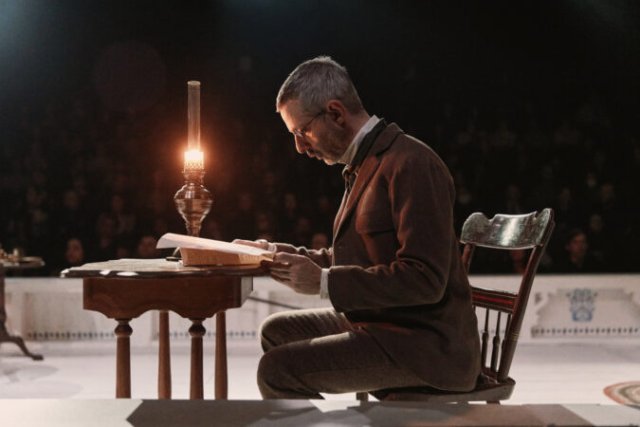Henrick Ibsen’s An Enemy of the People is getting a stunning revival on Broadway. audiences may be amazed by how many issues in the play equate to issues in our times.
At the figurative final curtain, I was stunned and moved, more than I have been with other productions I’ve seen.
Who is this “Enemy of the People”? He’s a doctor and scientist, Dr. Thomas Stockmann, who has discovered that the water supply feeding a popular tourist health spa is contaminated and can lead to serious illnesses and death. Shutting down and fixing the problem will take several years (apparently), thus destroying the booming economy of the small town, which has grown prosperous from the spa.
Jeremy Strong lets us see all sides of this man; he’s by turns politically naïve, dogmatic, unbending, stubborn, and with a streak of the martyr. Stockman is not an easy character to unequivocally like, yet at the end of the play, you both admire him and wonder if he is totally misguided.
It is this realism that Ibsen is known for, and which Amy Herzog has skillfully adapted and shortened, that propels the drama. When there are no easy answers, what do citizens do? That’s the underlying question.
The cynicism that Ibsen shows ties into our cynicism about the motives of business, government, and even the average citizen.
Ibsen throws in some complications. Dr. Stockman recently returned to his hometown to be the medical director of the spa after laboring for years in a remote and poor village. He and his family experienced the same deprivations as his patients; he now enjoys the luxuries this new position allows. He has surrounded himself with “friends” – all of whom will justify violating both the friendship and their expressed values.
To add another dimension, Dr. Stockmann’s brother, Peter, is the town’s mayor and was one of the driving forces supporting the spa and brought Dr. Stockmann home for the job. This brings in sibling rivalry; it seems the two do not have the closest of relationships. Each believes the spa was his idea. Peter is not above stretching the truth or perhaps creating it to stop Dr. Stockmann.
Director Sam Gold is working with the in-the-round (or rather oblong) stage at Circle in the Square. The audience sits on all sides. This can be a challenge both for the director and the cast, but Gold handles it well. The scenic design by the firm dots must depend mainly on quick prop changes to set the various scenes. Isabella Byrd (lighting design) and Mikaal Sulaiman (sound design) must set the time and place.
I was pleased that Herzog did not reset the play in a misguided attempt to make it “relevant.” It is relevant even if it is set in the late 1800s in Norway. It is the enduring issues that are relevant.
The cast and what God has brought out of them is the strength of this production. Strong is the center of the play; he projects quiet dignity but also moral certitude. Michael Imperioli is more flamboyant as Peter Stockmann. If Strong is reserved, Imperioli brings energy to the role. You can immediately identify him as a politician who will know how to get his own way. It is interesting that each looks exactly how you would picture these characters.
Caleb Eberhardt plays the radical editor of the local paper, Hovstad. Yet, you are not surprised when he turns on Dr. Stockmann. It seems in line with his underlying moral ambiguity. Matthew August Jeffers plays his assistant; they both talk a good game but crumble like a stack of cards.
Thomas Jay Ryan plays the printer Aslaksen. From his mild manner and calming voice, you just know that his word cannot be relied upon.
Not everything is perfect. Dr. Stockmann’s daughter, Petra, could be another counterpoint to her father’s position—supportive but practical. As played by Victoria Pedretti, Petra’s inner strength could be better conveyed. The same goes for Captain Horster, a mariner who befriends Stockmann when everything is collapsing.
One other misstep by Gold. While the play has no official intermission, a break is partway through. It is announced as a five-minute break, but it runs longer. Why? The audience is invited down to the stage for small cups of aquavit, the strong Scandinavian alcohol. It takes much longer than five minutes and interrupts the tension.
When Dr. Stockmann is destroyed, he refuses to accept the bleak future waiting for him in the town, where he has been called “an enemy of the people.” His last lines, and I paraphrase, are “The sun broke through. It’s been a long time since I’ve seen the sun.”

